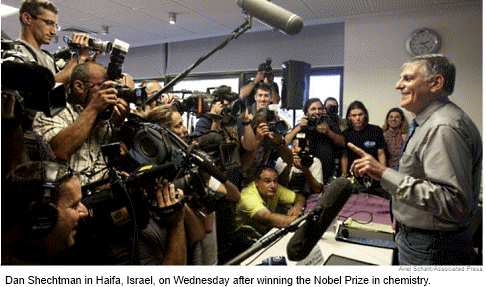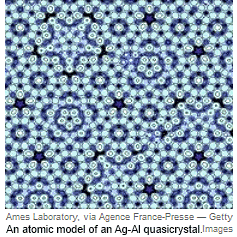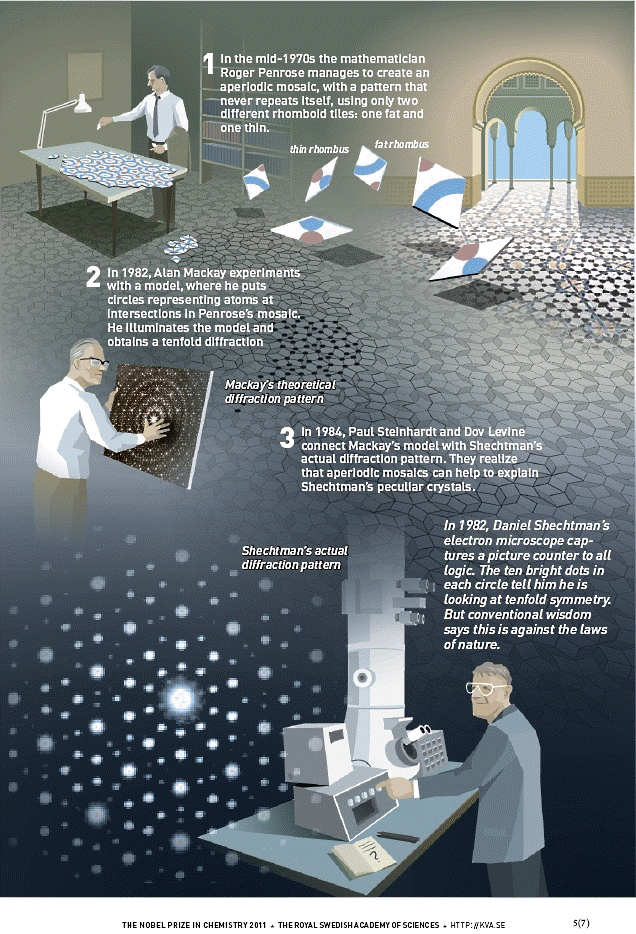|
News & Views item - October 2011 |
![]() 2011 Nobel Prize in Chemistry "for he Discovery of
Quasicrystals". (October 6, 2011)
2011 Nobel Prize in Chemistry "for he Discovery of
Quasicrystals". (October 6, 2011)
The Royal Swedish Academy of Sciences has decided to award the Nobel Prize in Chemistry for 2011 to Dan Shechtman, Technion - Israel Institute of Technology, Haifa, Israel for the discovery of quasicrystals.

The Academy's media release reads:
On the morning of 8 April 1982, an image counter to the laws of nature
appeared in Dan Shechtman's electron microscope. In all solid matter, atoms were
believed to be packed inside crystals in symmetrical patterns that were repeated
periodically over and over again. For scientists, this repetition was required
in order to obtain a crystal.
Shechtman's image, however, showed that the atoms in his crystal were packed in
a pattern that could not be repeated. Such a pattern was considered just as
impossible as creating a football using only six-cornered polygons, when a
sphere needs both five- and six-cornered polygons. His discovery was extremely
controversial. In the course of defending his findings, he was asked to leave
his research group. However, his battle eventually forced scientists to
reconsider their conception of the very nature of matter.
Aperiodic mosaics, such as those found in the medieval Islamic mosaics of the
Alhambra Palace in Spain and the Darb-i Imam Shrine in Iran, have helped
scientists understand what quasicrystals look like at the atomic level. In those
mosaics, as in quasicrystals, the patterns are regular - they follow
mathematical rules - but they never repeat themselves.
When scientists describe Shechtman's quasicrystals, they use a concept that
comes from mathematics and art: the golden ratio. This number had already caught the interest of mathematicians in Ancient Greece, as it often appeared in
geometry. In quasicrystals, for instance, the ratio of various distances between
atoms is related to the golden mean.
caught the interest of mathematicians in Ancient Greece, as it often appeared in
geometry. In quasicrystals, for instance, the ratio of various distances between
atoms is related to the golden mean.
Following Shechtman's discovery, scientists have produced other kinds of
quasicrystals in the lab and discovered naturally occurring quasicrystals in
mineral samples from a Russian river. A Swedish company has also found
quasicrystals in a certain form of steel, where the crystals reinforce the
material like armor. Scientists are currently experimenting with using
quasicrystals in different products such as frying pans and diesel engines.
In quasicrystals, we find the fascinating mosaics of the Arabic world reproduced at the level of atoms: regular patterns that never repeat themselves. However, the configuration found in quasicrystals was considered impossible, and Dan Shechtman had to fight a fierce battle against established science. The Nobel Prize in Chemistry 2011 has fundamentally altered how chemists conceive of solid matter.
Nancy B. Jackson, president of the American Chemical Society told The New York Times: "When he first discovered these materials, nobody thought they could exist. It was one of these great scientific stories that his fellow scientists thought was impossible, but through time, people came to realize he was right." In fact the definition of crystal had to be changed. No longer defined as having "a regularly ordered, repeating three-dimensional pattern," according to the International Union of Crystallography. The definition adopted in 1992, describes it as a solid with a "discrete diffraction diagram", i.e. something that produces diffraction patterns comparable to those Dr. Shechtman observed.
As to practical applications they have been limited: "The applications haven’t panned out,” said Patricia A. Thiel, a colleague of Dr. Shechtman at Iowa State and Ames Laboratory who also studies quasicrystals. "But they revolutionized our understanding of how atoms arrange themselves in solids. It was a scientific revolution."

_______________________________________
Dan Shechtman, Israeli citizen. Born 1941 in
Tel Aviv, Israel. Ph.D. 1972 from Technion - Israel Institute of Technology,
Haifa, Israel. Distinguished Professor, The Philip Tobias Chair, Technion -
Israel Institute of Technology, Haifa, Israel.
http://materials.technion.ac.il/shechtman.html
Information for the Public Pdf 3 MB
Scientific Background Pdf 1,3 MB